Critical Analysis: Skin Glue Impact on Intravenous Catheter Outcomes
VerifiedAdded on 2021/06/15
|10
|2615
|27
Essay
AI Summary
This essay provides a detailed analysis of a research article investigating the effectiveness of skin glue in reducing the failure rate of peripheral intravenous catheters inserted in emergency departments. The analysis covers key aspects of the study, including the introduction, research design (a single-site, 2-arm, non-blinded, randomized, controlled trial), sampling methods (purposive sampling), data collection and analysis techniques, and the presentation and interpretation of results. The study found a significant reduction in device failure among patients treated with skin glue compared to standard care. The essay concludes by discussing the relevance of these findings to clinical nursing practice and suggesting directions for future research, including addressing limitations and exploring the cost-effectiveness of skin glue application. The analyzed article highlights the potential for skin glue to improve patient outcomes by reducing catheter failures, contributing valuable insights to the field of medical practice.
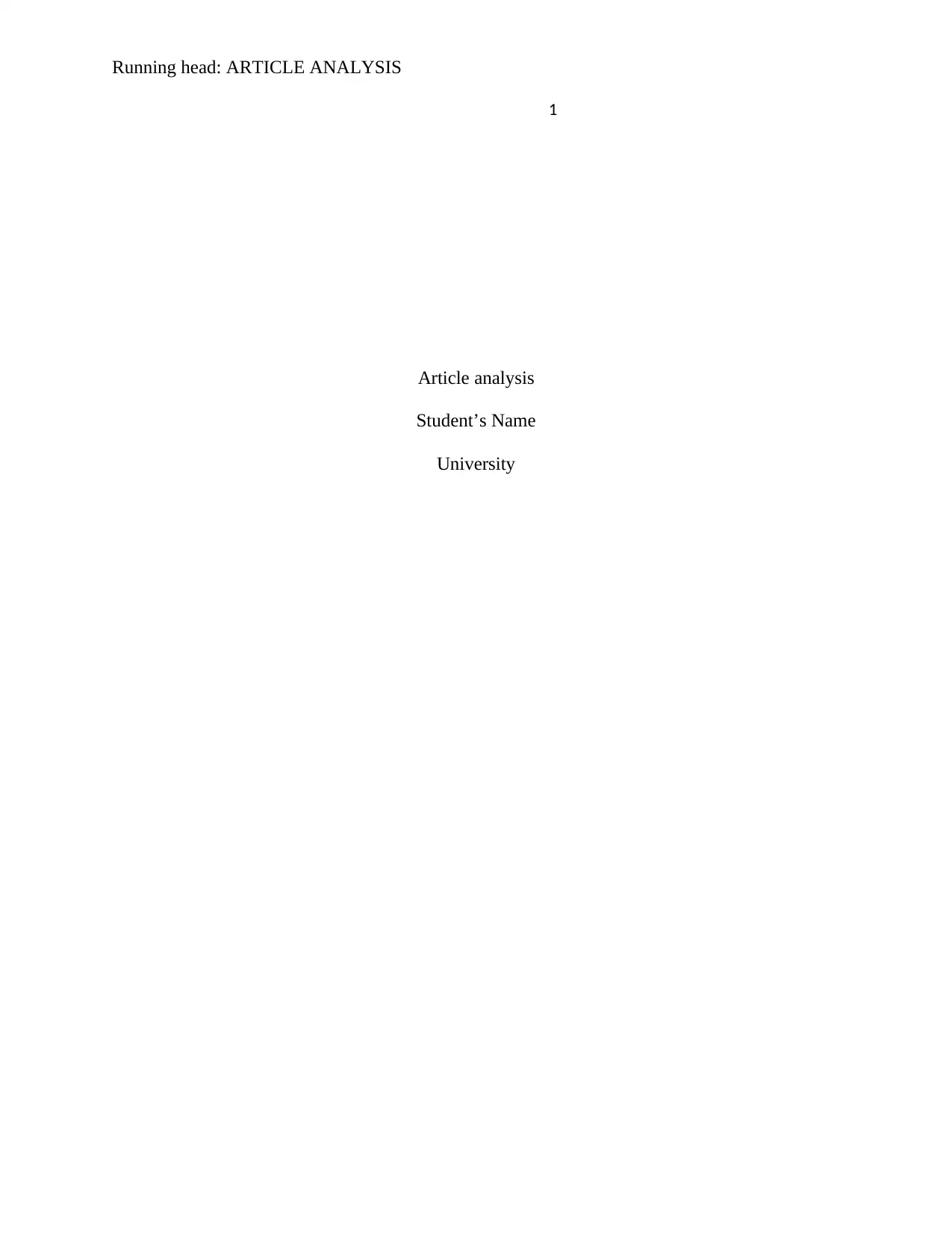
Running head: ARTICLE ANALYSIS
1
Article analysis
Student’s Name
University
1
Article analysis
Student’s Name
University
Paraphrase This Document
Need a fresh take? Get an instant paraphrase of this document with our AI Paraphraser
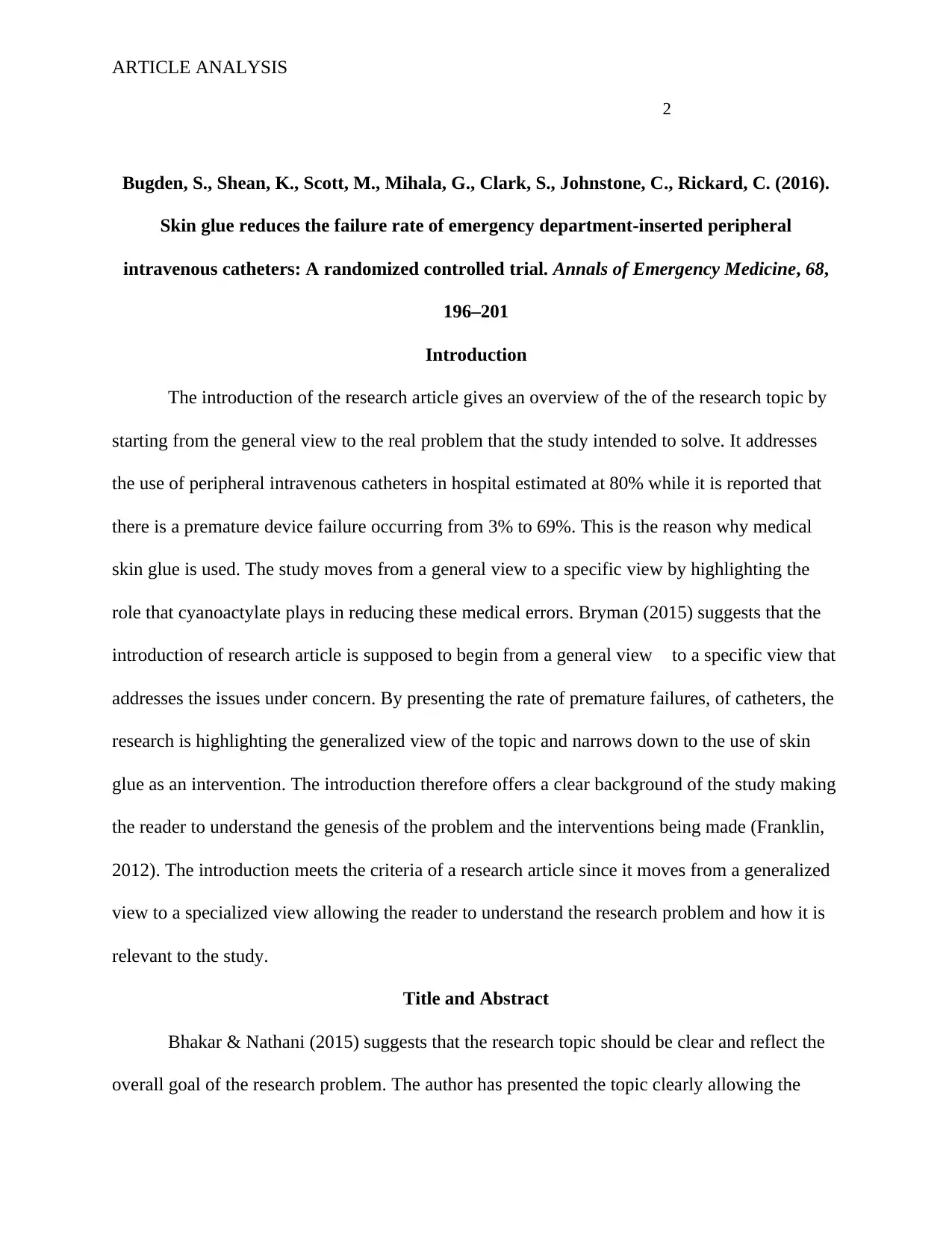
ARTICLE ANALYSIS
2
Bugden, S., Shean, K., Scott, M., Mihala, G., Clark, S., Johnstone, C., Rickard, C. (2016).
Skin glue reduces the failure rate of emergency department-inserted peripheral
intravenous catheters: A randomized controlled trial. Annals of Emergency Medicine, 68,
196–201
Introduction
The introduction of the research article gives an overview of the of the research topic by
starting from the general view to the real problem that the study intended to solve. It addresses
the use of peripheral intravenous catheters in hospital estimated at 80% while it is reported that
there is a premature device failure occurring from 3% to 69%. This is the reason why medical
skin glue is used. The study moves from a general view to a specific view by highlighting the
role that cyanoactylate plays in reducing these medical errors. Bryman (2015) suggests that the
introduction of research article is supposed to begin from a general view to a specific view that
addresses the issues under concern. By presenting the rate of premature failures, of catheters, the
research is highlighting the generalized view of the topic and narrows down to the use of skin
glue as an intervention. The introduction therefore offers a clear background of the study making
the reader to understand the genesis of the problem and the interventions being made (Franklin,
2012). The introduction meets the criteria of a research article since it moves from a generalized
view to a specialized view allowing the reader to understand the research problem and how it is
relevant to the study.
Title and Abstract
Bhakar & Nathani (2015) suggests that the research topic should be clear and reflect the
overall goal of the research problem. The author has presented the topic clearly allowing the
2
Bugden, S., Shean, K., Scott, M., Mihala, G., Clark, S., Johnstone, C., Rickard, C. (2016).
Skin glue reduces the failure rate of emergency department-inserted peripheral
intravenous catheters: A randomized controlled trial. Annals of Emergency Medicine, 68,
196–201
Introduction
The introduction of the research article gives an overview of the of the research topic by
starting from the general view to the real problem that the study intended to solve. It addresses
the use of peripheral intravenous catheters in hospital estimated at 80% while it is reported that
there is a premature device failure occurring from 3% to 69%. This is the reason why medical
skin glue is used. The study moves from a general view to a specific view by highlighting the
role that cyanoactylate plays in reducing these medical errors. Bryman (2015) suggests that the
introduction of research article is supposed to begin from a general view to a specific view that
addresses the issues under concern. By presenting the rate of premature failures, of catheters, the
research is highlighting the generalized view of the topic and narrows down to the use of skin
glue as an intervention. The introduction therefore offers a clear background of the study making
the reader to understand the genesis of the problem and the interventions being made (Franklin,
2012). The introduction meets the criteria of a research article since it moves from a generalized
view to a specialized view allowing the reader to understand the research problem and how it is
relevant to the study.
Title and Abstract
Bhakar & Nathani (2015) suggests that the research topic should be clear and reflect the
overall goal of the research problem. The author has presented the topic clearly allowing the
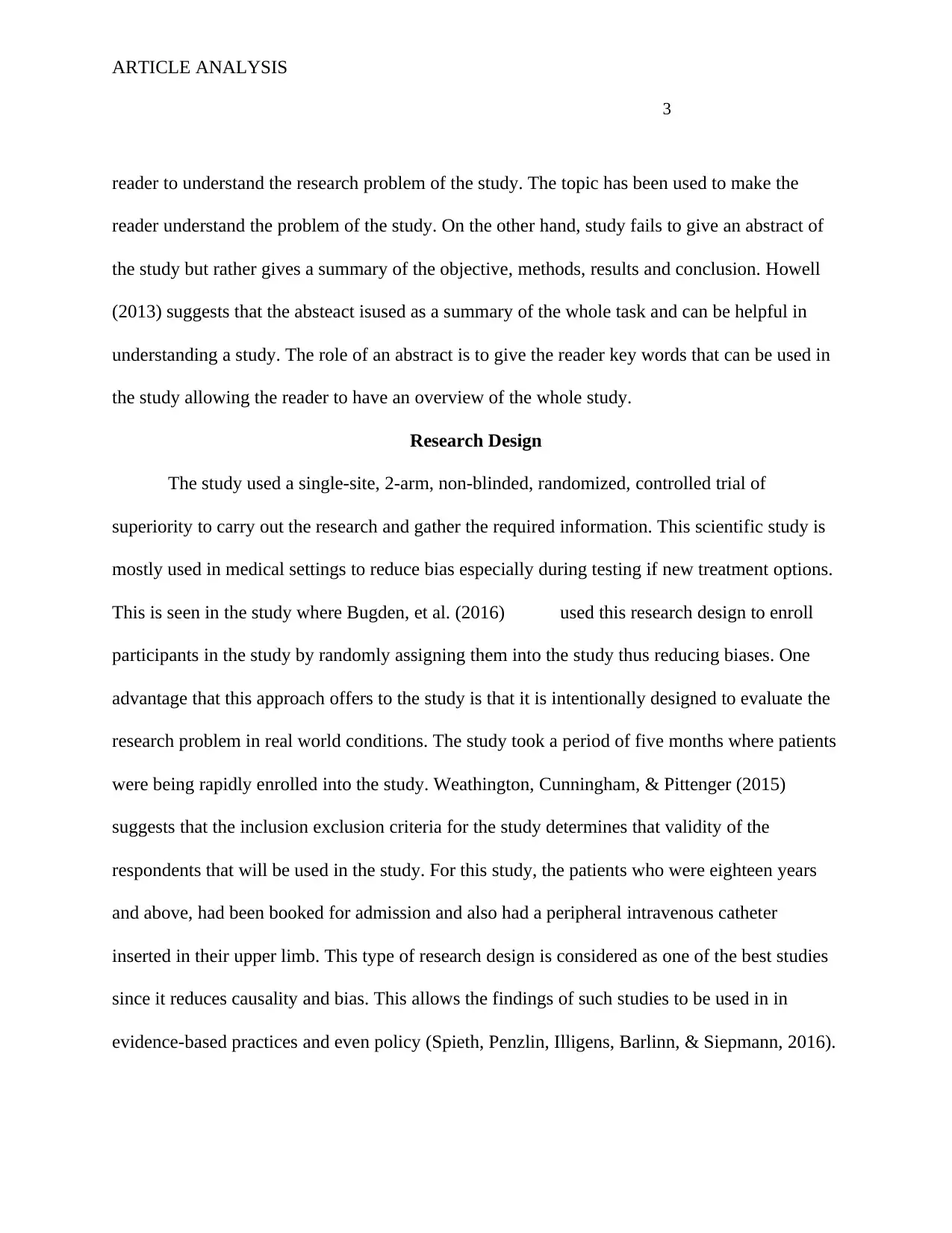
ARTICLE ANALYSIS
3
reader to understand the research problem of the study. The topic has been used to make the
reader understand the problem of the study. On the other hand, study fails to give an abstract of
the study but rather gives a summary of the objective, methods, results and conclusion. Howell
(2013) suggests that the absteact isused as a summary of the whole task and can be helpful in
understanding a study. The role of an abstract is to give the reader key words that can be used in
the study allowing the reader to have an overview of the whole study.
Research Design
The study used a single-site, 2-arm, non-blinded, randomized, controlled trial of
superiority to carry out the research and gather the required information. This scientific study is
mostly used in medical settings to reduce bias especially during testing if new treatment options.
This is seen in the study where Bugden, et al. (2016) used this research design to enroll
participants in the study by randomly assigning them into the study thus reducing biases. One
advantage that this approach offers to the study is that it is intentionally designed to evaluate the
research problem in real world conditions. The study took a period of five months where patients
were being rapidly enrolled into the study. Weathington, Cunningham, & Pittenger (2015)
suggests that the inclusion exclusion criteria for the study determines that validity of the
respondents that will be used in the study. For this study, the patients who were eighteen years
and above, had been booked for admission and also had a peripheral intravenous catheter
inserted in their upper limb. This type of research design is considered as one of the best studies
since it reduces causality and bias. This allows the findings of such studies to be used in in
evidence-based practices and even policy (Spieth, Penzlin, Illigens, Barlinn, & Siepmann, 2016).
3
reader to understand the research problem of the study. The topic has been used to make the
reader understand the problem of the study. On the other hand, study fails to give an abstract of
the study but rather gives a summary of the objective, methods, results and conclusion. Howell
(2013) suggests that the absteact isused as a summary of the whole task and can be helpful in
understanding a study. The role of an abstract is to give the reader key words that can be used in
the study allowing the reader to have an overview of the whole study.
Research Design
The study used a single-site, 2-arm, non-blinded, randomized, controlled trial of
superiority to carry out the research and gather the required information. This scientific study is
mostly used in medical settings to reduce bias especially during testing if new treatment options.
This is seen in the study where Bugden, et al. (2016) used this research design to enroll
participants in the study by randomly assigning them into the study thus reducing biases. One
advantage that this approach offers to the study is that it is intentionally designed to evaluate the
research problem in real world conditions. The study took a period of five months where patients
were being rapidly enrolled into the study. Weathington, Cunningham, & Pittenger (2015)
suggests that the inclusion exclusion criteria for the study determines that validity of the
respondents that will be used in the study. For this study, the patients who were eighteen years
and above, had been booked for admission and also had a peripheral intravenous catheter
inserted in their upper limb. This type of research design is considered as one of the best studies
since it reduces causality and bias. This allows the findings of such studies to be used in in
evidence-based practices and even policy (Spieth, Penzlin, Illigens, Barlinn, & Siepmann, 2016).
⊘ This is a preview!⊘
Do you want full access?
Subscribe today to unlock all pages.

Trusted by 1+ million students worldwide
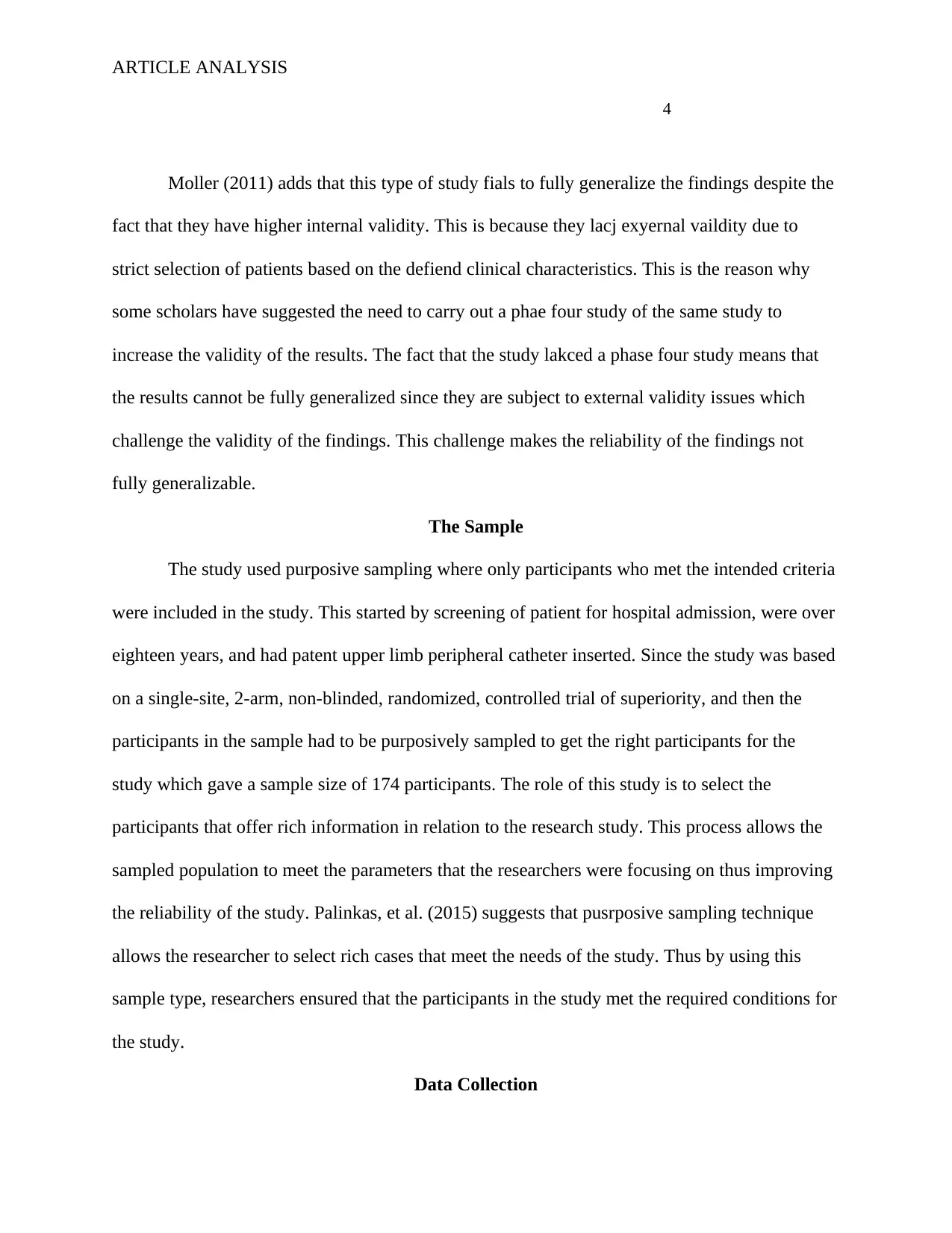
ARTICLE ANALYSIS
4
Moller (2011) adds that this type of study fials to fully generalize the findings despite the
fact that they have higher internal validity. This is because they lacj exyernal vaildity due to
strict selection of patients based on the defiend clinical characteristics. This is the reason why
some scholars have suggested the need to carry out a phae four study of the same study to
increase the validity of the results. The fact that the study lakced a phase four study means that
the results cannot be fully generalized since they are subject to external validity issues which
challenge the validity of the findings. This challenge makes the reliability of the findings not
fully generalizable.
The Sample
The study used purposive sampling where only participants who met the intended criteria
were included in the study. This started by screening of patient for hospital admission, were over
eighteen years, and had patent upper limb peripheral catheter inserted. Since the study was based
on a single-site, 2-arm, non-blinded, randomized, controlled trial of superiority, and then the
participants in the sample had to be purposively sampled to get the right participants for the
study which gave a sample size of 174 participants. The role of this study is to select the
participants that offer rich information in relation to the research study. This process allows the
sampled population to meet the parameters that the researchers were focusing on thus improving
the reliability of the study. Palinkas, et al. (2015) suggests that pusrposive sampling technique
allows the researcher to select rich cases that meet the needs of the study. Thus by using this
sample type, researchers ensured that the participants in the study met the required conditions for
the study.
Data Collection
4
Moller (2011) adds that this type of study fials to fully generalize the findings despite the
fact that they have higher internal validity. This is because they lacj exyernal vaildity due to
strict selection of patients based on the defiend clinical characteristics. This is the reason why
some scholars have suggested the need to carry out a phae four study of the same study to
increase the validity of the results. The fact that the study lakced a phase four study means that
the results cannot be fully generalized since they are subject to external validity issues which
challenge the validity of the findings. This challenge makes the reliability of the findings not
fully generalizable.
The Sample
The study used purposive sampling where only participants who met the intended criteria
were included in the study. This started by screening of patient for hospital admission, were over
eighteen years, and had patent upper limb peripheral catheter inserted. Since the study was based
on a single-site, 2-arm, non-blinded, randomized, controlled trial of superiority, and then the
participants in the sample had to be purposively sampled to get the right participants for the
study which gave a sample size of 174 participants. The role of this study is to select the
participants that offer rich information in relation to the research study. This process allows the
sampled population to meet the parameters that the researchers were focusing on thus improving
the reliability of the study. Palinkas, et al. (2015) suggests that pusrposive sampling technique
allows the researcher to select rich cases that meet the needs of the study. Thus by using this
sample type, researchers ensured that the participants in the study met the required conditions for
the study.
Data Collection
Paraphrase This Document
Need a fresh take? Get an instant paraphrase of this document with our AI Paraphraser
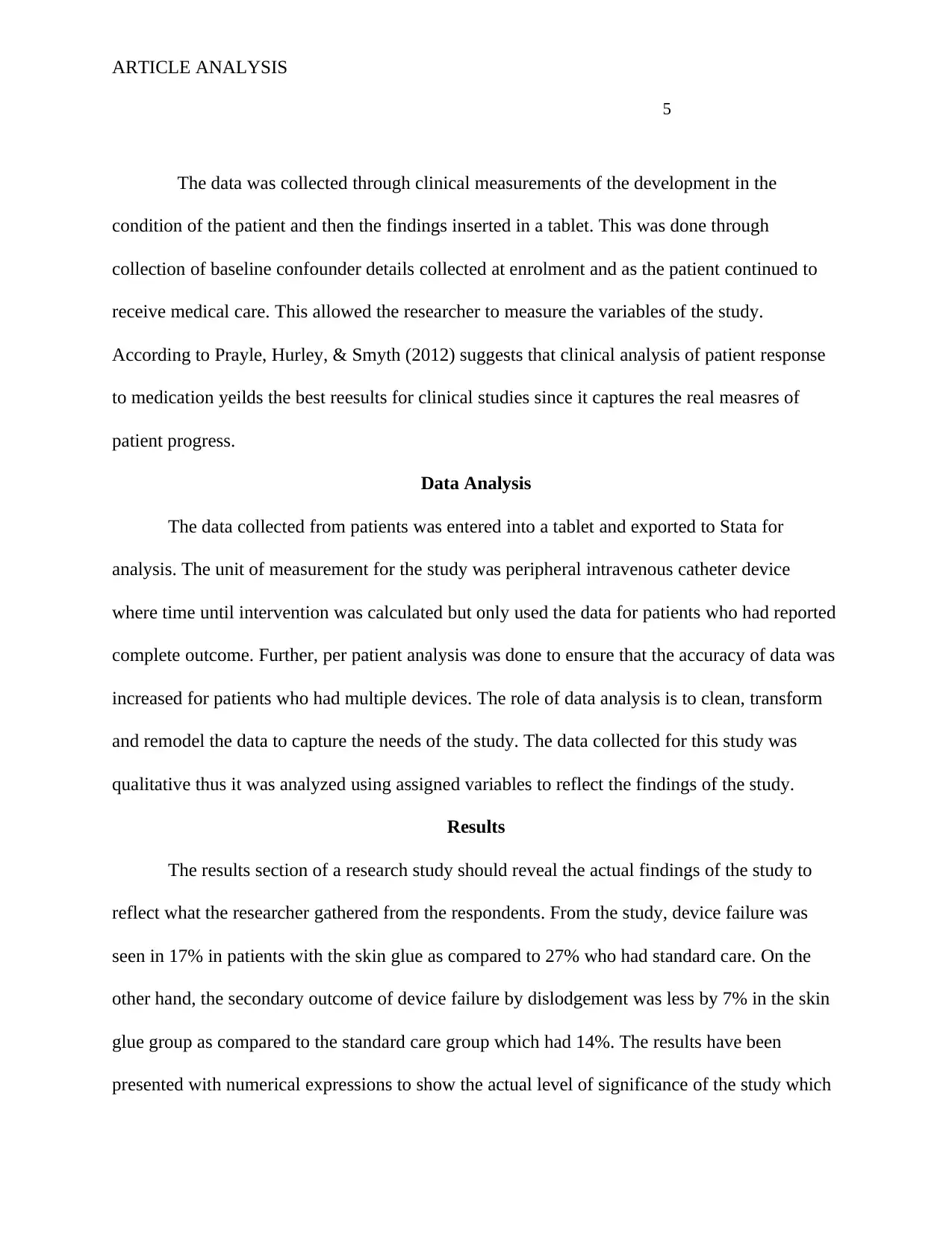
ARTICLE ANALYSIS
5
The data was collected through clinical measurements of the development in the
condition of the patient and then the findings inserted in a tablet. This was done through
collection of baseline confounder details collected at enrolment and as the patient continued to
receive medical care. This allowed the researcher to measure the variables of the study.
According to Prayle, Hurley, & Smyth (2012) suggests that clinical analysis of patient response
to medication yeilds the best reesults for clinical studies since it captures the real measres of
patient progress.
Data Analysis
The data collected from patients was entered into a tablet and exported to Stata for
analysis. The unit of measurement for the study was peripheral intravenous catheter device
where time until intervention was calculated but only used the data for patients who had reported
complete outcome. Further, per patient analysis was done to ensure that the accuracy of data was
increased for patients who had multiple devices. The role of data analysis is to clean, transform
and remodel the data to capture the needs of the study. The data collected for this study was
qualitative thus it was analyzed using assigned variables to reflect the findings of the study.
Results
The results section of a research study should reveal the actual findings of the study to
reflect what the researcher gathered from the respondents. From the study, device failure was
seen in 17% in patients with the skin glue as compared to 27% who had standard care. On the
other hand, the secondary outcome of device failure by dislodgement was less by 7% in the skin
glue group as compared to the standard care group which had 14%. The results have been
presented with numerical expressions to show the actual level of significance of the study which
5
The data was collected through clinical measurements of the development in the
condition of the patient and then the findings inserted in a tablet. This was done through
collection of baseline confounder details collected at enrolment and as the patient continued to
receive medical care. This allowed the researcher to measure the variables of the study.
According to Prayle, Hurley, & Smyth (2012) suggests that clinical analysis of patient response
to medication yeilds the best reesults for clinical studies since it captures the real measres of
patient progress.
Data Analysis
The data collected from patients was entered into a tablet and exported to Stata for
analysis. The unit of measurement for the study was peripheral intravenous catheter device
where time until intervention was calculated but only used the data for patients who had reported
complete outcome. Further, per patient analysis was done to ensure that the accuracy of data was
increased for patients who had multiple devices. The role of data analysis is to clean, transform
and remodel the data to capture the needs of the study. The data collected for this study was
qualitative thus it was analyzed using assigned variables to reflect the findings of the study.
Results
The results section of a research study should reveal the actual findings of the study to
reflect what the researcher gathered from the respondents. From the study, device failure was
seen in 17% in patients with the skin glue as compared to 27% who had standard care. On the
other hand, the secondary outcome of device failure by dislodgement was less by 7% in the skin
glue group as compared to the standard care group which had 14%. The results have been
presented with numerical expressions to show the actual level of significance of the study which
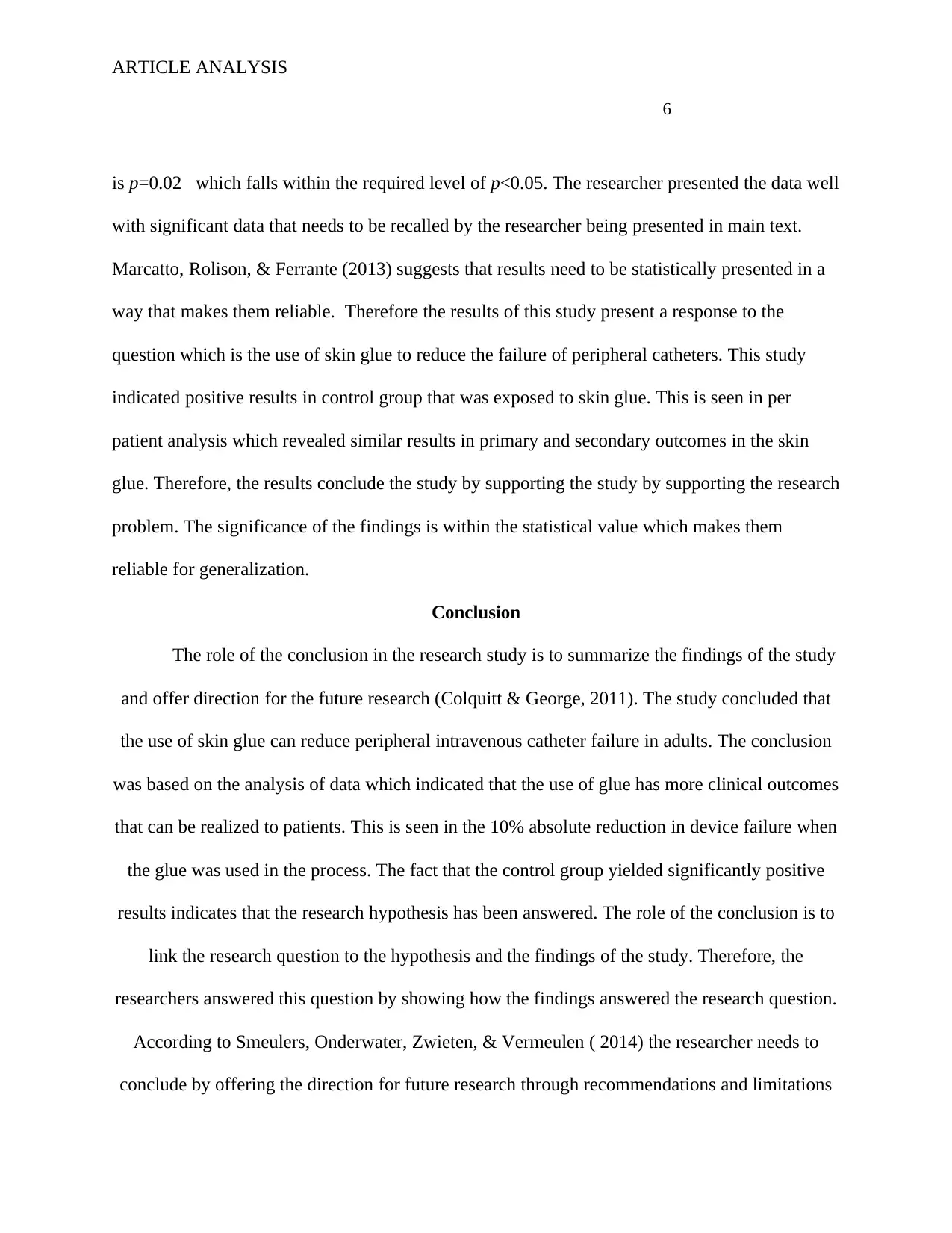
ARTICLE ANALYSIS
6
is p=0.02 which falls within the required level of p<0.05. The researcher presented the data well
with significant data that needs to be recalled by the researcher being presented in main text.
Marcatto, Rolison, & Ferrante (2013) suggests that results need to be statistically presented in a
way that makes them reliable. Therefore the results of this study present a response to the
question which is the use of skin glue to reduce the failure of peripheral catheters. This study
indicated positive results in control group that was exposed to skin glue. This is seen in per
patient analysis which revealed similar results in primary and secondary outcomes in the skin
glue. Therefore, the results conclude the study by supporting the study by supporting the research
problem. The significance of the findings is within the statistical value which makes them
reliable for generalization.
Conclusion
The role of the conclusion in the research study is to summarize the findings of the study
and offer direction for the future research (Colquitt & George, 2011). The study concluded that
the use of skin glue can reduce peripheral intravenous catheter failure in adults. The conclusion
was based on the analysis of data which indicated that the use of glue has more clinical outcomes
that can be realized to patients. This is seen in the 10% absolute reduction in device failure when
the glue was used in the process. The fact that the control group yielded significantly positive
results indicates that the research hypothesis has been answered. The role of the conclusion is to
link the research question to the hypothesis and the findings of the study. Therefore, the
researchers answered this question by showing how the findings answered the research question.
According to Smeulers, Onderwater, Zwieten, & Vermeulen ( 2014) the researcher needs to
conclude by offering the direction for future research through recommendations and limitations
6
is p=0.02 which falls within the required level of p<0.05. The researcher presented the data well
with significant data that needs to be recalled by the researcher being presented in main text.
Marcatto, Rolison, & Ferrante (2013) suggests that results need to be statistically presented in a
way that makes them reliable. Therefore the results of this study present a response to the
question which is the use of skin glue to reduce the failure of peripheral catheters. This study
indicated positive results in control group that was exposed to skin glue. This is seen in per
patient analysis which revealed similar results in primary and secondary outcomes in the skin
glue. Therefore, the results conclude the study by supporting the study by supporting the research
problem. The significance of the findings is within the statistical value which makes them
reliable for generalization.
Conclusion
The role of the conclusion in the research study is to summarize the findings of the study
and offer direction for the future research (Colquitt & George, 2011). The study concluded that
the use of skin glue can reduce peripheral intravenous catheter failure in adults. The conclusion
was based on the analysis of data which indicated that the use of glue has more clinical outcomes
that can be realized to patients. This is seen in the 10% absolute reduction in device failure when
the glue was used in the process. The fact that the control group yielded significantly positive
results indicates that the research hypothesis has been answered. The role of the conclusion is to
link the research question to the hypothesis and the findings of the study. Therefore, the
researchers answered this question by showing how the findings answered the research question.
According to Smeulers, Onderwater, Zwieten, & Vermeulen ( 2014) the researcher needs to
conclude by offering the direction for future research through recommendations and limitations
⊘ This is a preview!⊘
Do you want full access?
Subscribe today to unlock all pages.

Trusted by 1+ million students worldwide
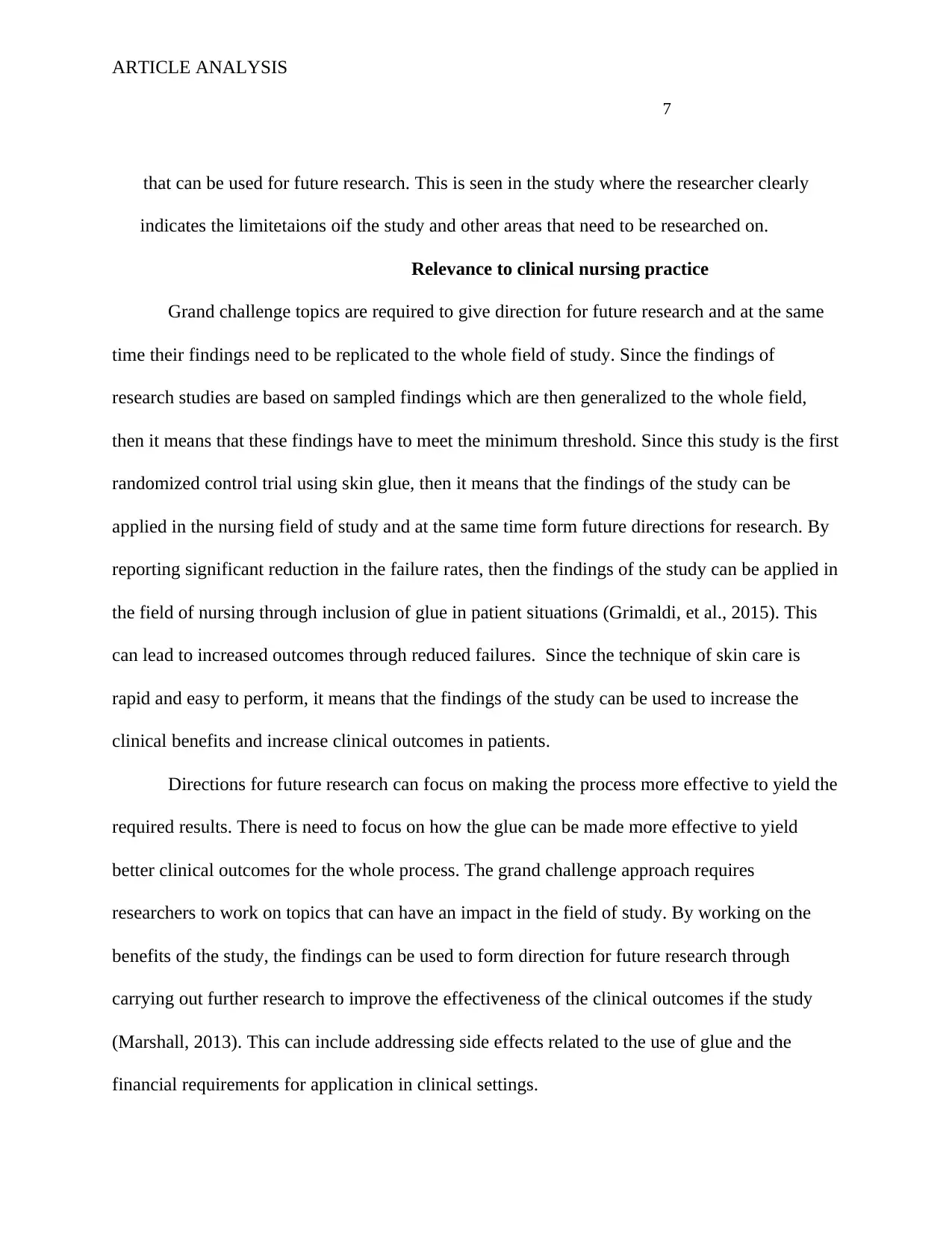
ARTICLE ANALYSIS
7
that can be used for future research. This is seen in the study where the researcher clearly
indicates the limitetaions oif the study and other areas that need to be researched on.
Relevance to clinical nursing practice
Grand challenge topics are required to give direction for future research and at the same
time their findings need to be replicated to the whole field of study. Since the findings of
research studies are based on sampled findings which are then generalized to the whole field,
then it means that these findings have to meet the minimum threshold. Since this study is the first
randomized control trial using skin glue, then it means that the findings of the study can be
applied in the nursing field of study and at the same time form future directions for research. By
reporting significant reduction in the failure rates, then the findings of the study can be applied in
the field of nursing through inclusion of glue in patient situations (Grimaldi, et al., 2015). This
can lead to increased outcomes through reduced failures. Since the technique of skin care is
rapid and easy to perform, it means that the findings of the study can be used to increase the
clinical benefits and increase clinical outcomes in patients.
Directions for future research can focus on making the process more effective to yield the
required results. There is need to focus on how the glue can be made more effective to yield
better clinical outcomes for the whole process. The grand challenge approach requires
researchers to work on topics that can have an impact in the field of study. By working on the
benefits of the study, the findings can be used to form direction for future research through
carrying out further research to improve the effectiveness of the clinical outcomes if the study
(Marshall, 2013). This can include addressing side effects related to the use of glue and the
financial requirements for application in clinical settings.
7
that can be used for future research. This is seen in the study where the researcher clearly
indicates the limitetaions oif the study and other areas that need to be researched on.
Relevance to clinical nursing practice
Grand challenge topics are required to give direction for future research and at the same
time their findings need to be replicated to the whole field of study. Since the findings of
research studies are based on sampled findings which are then generalized to the whole field,
then it means that these findings have to meet the minimum threshold. Since this study is the first
randomized control trial using skin glue, then it means that the findings of the study can be
applied in the nursing field of study and at the same time form future directions for research. By
reporting significant reduction in the failure rates, then the findings of the study can be applied in
the field of nursing through inclusion of glue in patient situations (Grimaldi, et al., 2015). This
can lead to increased outcomes through reduced failures. Since the technique of skin care is
rapid and easy to perform, it means that the findings of the study can be used to increase the
clinical benefits and increase clinical outcomes in patients.
Directions for future research can focus on making the process more effective to yield the
required results. There is need to focus on how the glue can be made more effective to yield
better clinical outcomes for the whole process. The grand challenge approach requires
researchers to work on topics that can have an impact in the field of study. By working on the
benefits of the study, the findings can be used to form direction for future research through
carrying out further research to improve the effectiveness of the clinical outcomes if the study
(Marshall, 2013). This can include addressing side effects related to the use of glue and the
financial requirements for application in clinical settings.
Paraphrase This Document
Need a fresh take? Get an instant paraphrase of this document with our AI Paraphraser
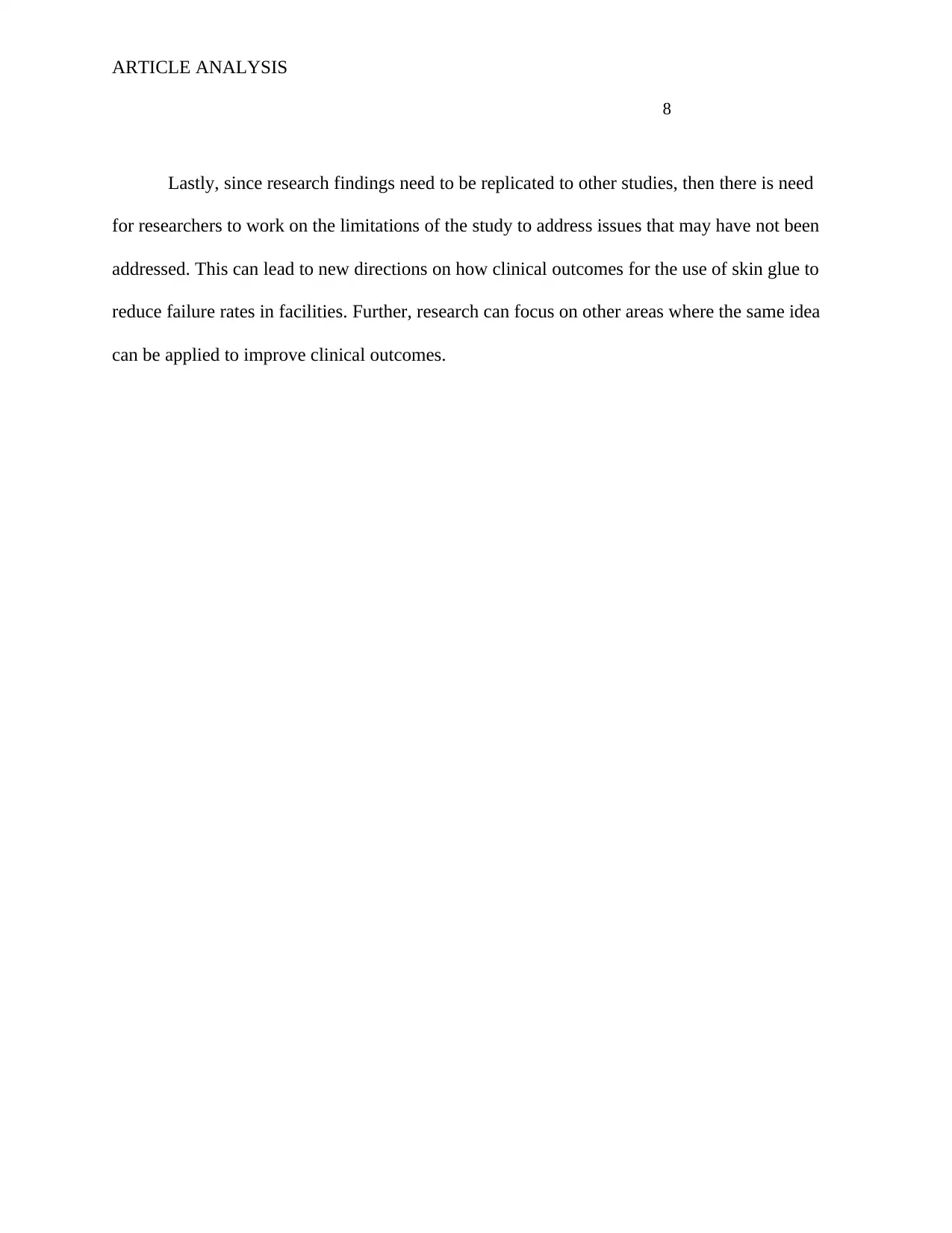
ARTICLE ANALYSIS
8
Lastly, since research findings need to be replicated to other studies, then there is need
for researchers to work on the limitations of the study to address issues that may have not been
addressed. This can lead to new directions on how clinical outcomes for the use of skin glue to
reduce failure rates in facilities. Further, research can focus on other areas where the same idea
can be applied to improve clinical outcomes.
8
Lastly, since research findings need to be replicated to other studies, then there is need
for researchers to work on the limitations of the study to address issues that may have not been
addressed. This can lead to new directions on how clinical outcomes for the use of skin glue to
reduce failure rates in facilities. Further, research can focus on other areas where the same idea
can be applied to improve clinical outcomes.
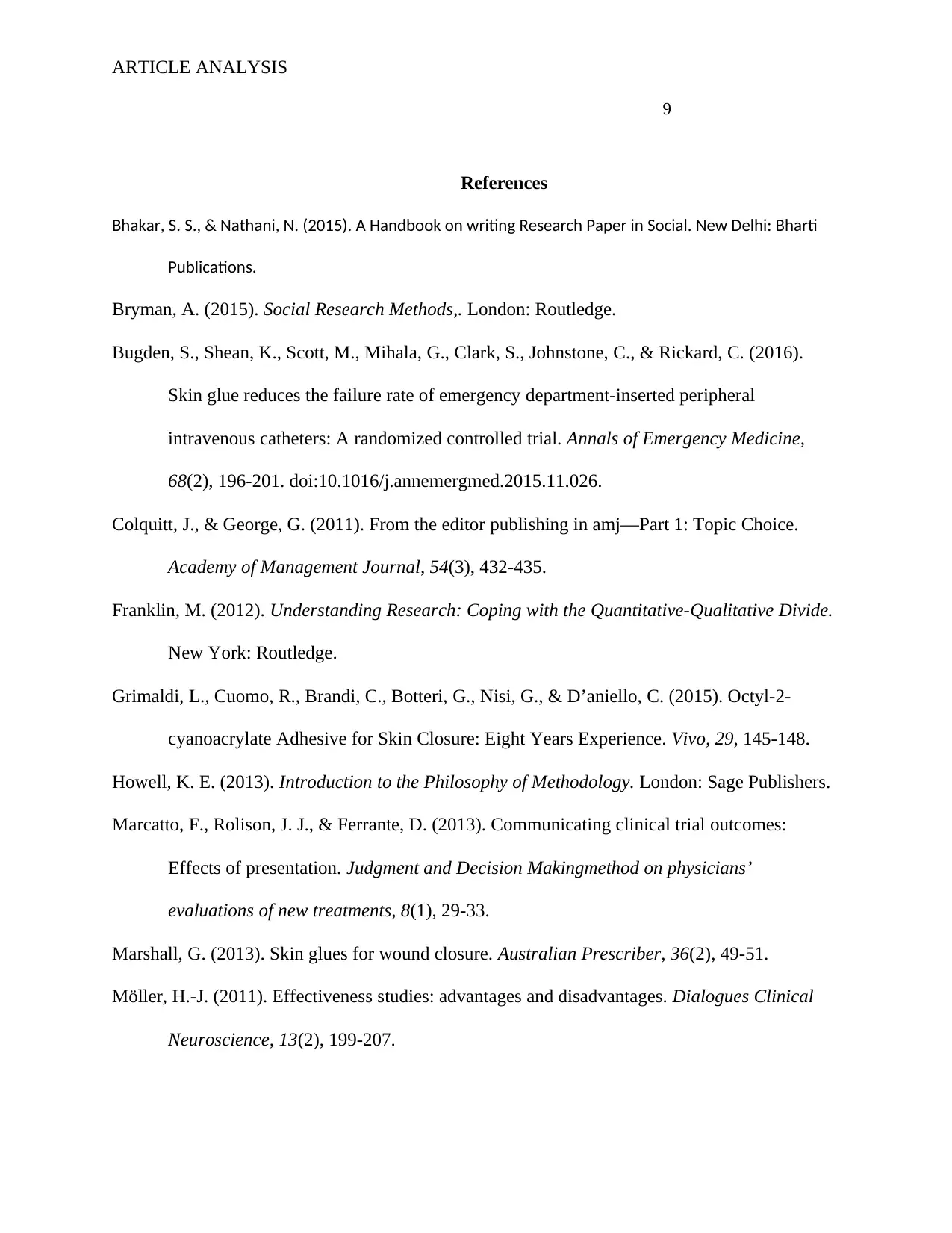
ARTICLE ANALYSIS
9
References
Bhakar, S. S., & Nathani, N. (2015). A Handbook on writing Research Paper in Social. New Delhi: Bharti
Publications.
Bryman, A. (2015). Social Research Methods,. London: Routledge.
Bugden, S., Shean, K., Scott, M., Mihala, G., Clark, S., Johnstone, C., & Rickard, C. (2016).
Skin glue reduces the failure rate of emergency department-inserted peripheral
intravenous catheters: A randomized controlled trial. Annals of Emergency Medicine,
68(2), 196-201. doi:10.1016/j.annemergmed.2015.11.026.
Colquitt, J., & George, G. (2011). From the editor publishing in amj—Part 1: Topic Choice.
Academy of Management Journal, 54(3), 432-435.
Franklin, M. (2012). Understanding Research: Coping with the Quantitative-Qualitative Divide.
New York: Routledge.
Grimaldi, L., Cuomo, R., Brandi, C., Botteri, G., Nisi, G., & D’aniello, C. (2015). Octyl-2-
cyanoacrylate Adhesive for Skin Closure: Eight Years Experience. Vivo, 29, 145-148.
Howell, K. E. (2013). Introduction to the Philosophy of Methodology. London: Sage Publishers.
Marcatto, F., Rolison, J. J., & Ferrante, D. (2013). Communicating clinical trial outcomes:
Effects of presentation. Judgment and Decision Makingmethod on physicians’
evaluations of new treatments, 8(1), 29-33.
Marshall, G. (2013). Skin glues for wound closure. Australian Prescriber, 36(2), 49-51.
Möller, H.-J. (2011). Effectiveness studies: advantages and disadvantages. Dialogues Clinical
Neuroscience, 13(2), 199-207.
9
References
Bhakar, S. S., & Nathani, N. (2015). A Handbook on writing Research Paper in Social. New Delhi: Bharti
Publications.
Bryman, A. (2015). Social Research Methods,. London: Routledge.
Bugden, S., Shean, K., Scott, M., Mihala, G., Clark, S., Johnstone, C., & Rickard, C. (2016).
Skin glue reduces the failure rate of emergency department-inserted peripheral
intravenous catheters: A randomized controlled trial. Annals of Emergency Medicine,
68(2), 196-201. doi:10.1016/j.annemergmed.2015.11.026.
Colquitt, J., & George, G. (2011). From the editor publishing in amj—Part 1: Topic Choice.
Academy of Management Journal, 54(3), 432-435.
Franklin, M. (2012). Understanding Research: Coping with the Quantitative-Qualitative Divide.
New York: Routledge.
Grimaldi, L., Cuomo, R., Brandi, C., Botteri, G., Nisi, G., & D’aniello, C. (2015). Octyl-2-
cyanoacrylate Adhesive for Skin Closure: Eight Years Experience. Vivo, 29, 145-148.
Howell, K. E. (2013). Introduction to the Philosophy of Methodology. London: Sage Publishers.
Marcatto, F., Rolison, J. J., & Ferrante, D. (2013). Communicating clinical trial outcomes:
Effects of presentation. Judgment and Decision Makingmethod on physicians’
evaluations of new treatments, 8(1), 29-33.
Marshall, G. (2013). Skin glues for wound closure. Australian Prescriber, 36(2), 49-51.
Möller, H.-J. (2011). Effectiveness studies: advantages and disadvantages. Dialogues Clinical
Neuroscience, 13(2), 199-207.
⊘ This is a preview!⊘
Do you want full access?
Subscribe today to unlock all pages.

Trusted by 1+ million students worldwide
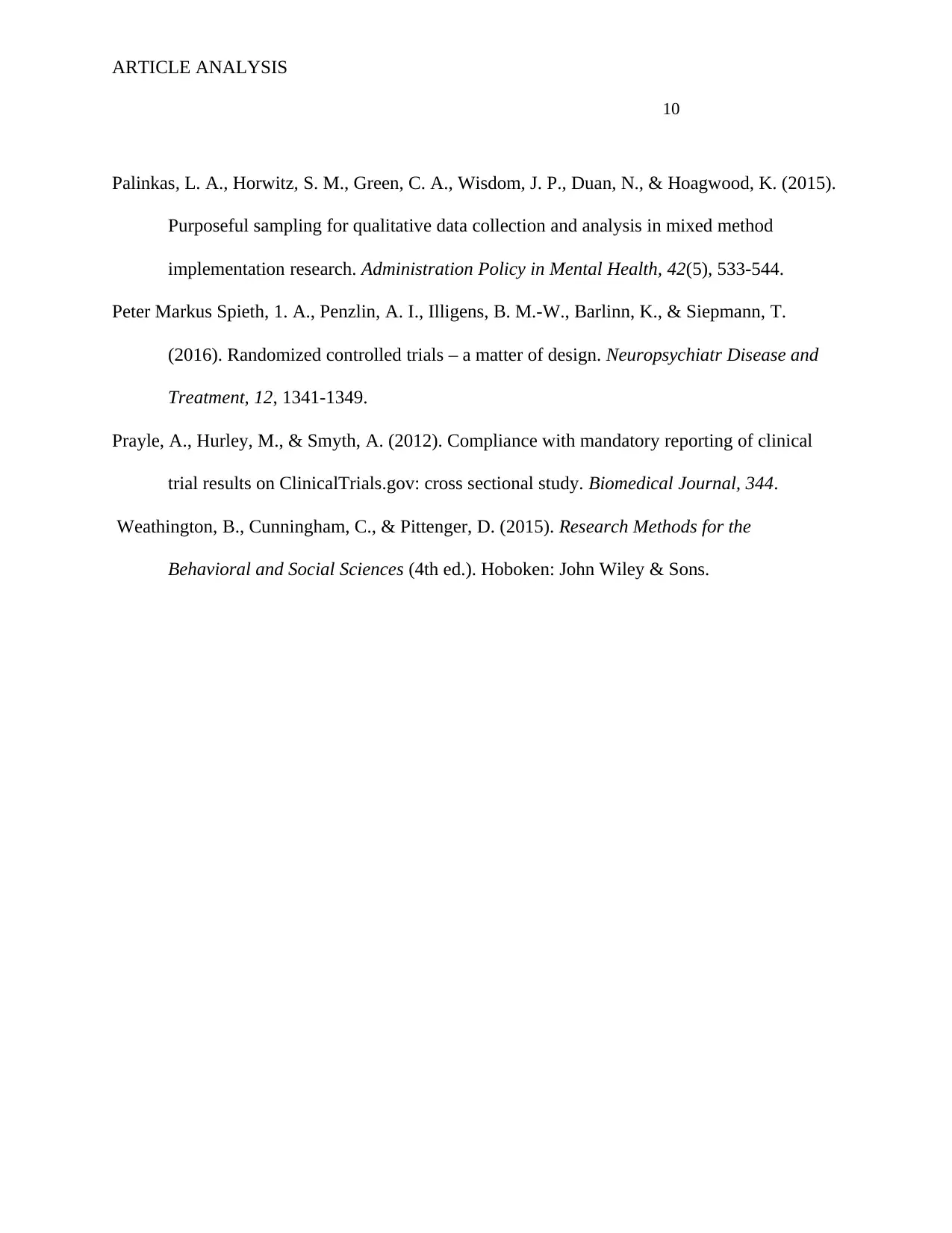
ARTICLE ANALYSIS
10
Palinkas, L. A., Horwitz, S. M., Green, C. A., Wisdom, J. P., Duan, N., & Hoagwood, K. (2015).
Purposeful sampling for qualitative data collection and analysis in mixed method
implementation research. Administration Policy in Mental Health, 42(5), 533-544.
Peter Markus Spieth, 1. A., Penzlin, A. I., Illigens, B. M.-W., Barlinn, K., & Siepmann, T.
(2016). Randomized controlled trials – a matter of design. Neuropsychiatr Disease and
Treatment, 12, 1341-1349.
Prayle, A., Hurley, M., & Smyth, A. (2012). Compliance with mandatory reporting of clinical
trial results on ClinicalTrials.gov: cross sectional study. Biomedical Journal, 344.
Weathington, B., Cunningham, C., & Pittenger, D. (2015). Research Methods for the
Behavioral and Social Sciences (4th ed.). Hoboken: John Wiley & Sons.
10
Palinkas, L. A., Horwitz, S. M., Green, C. A., Wisdom, J. P., Duan, N., & Hoagwood, K. (2015).
Purposeful sampling for qualitative data collection and analysis in mixed method
implementation research. Administration Policy in Mental Health, 42(5), 533-544.
Peter Markus Spieth, 1. A., Penzlin, A. I., Illigens, B. M.-W., Barlinn, K., & Siepmann, T.
(2016). Randomized controlled trials – a matter of design. Neuropsychiatr Disease and
Treatment, 12, 1341-1349.
Prayle, A., Hurley, M., & Smyth, A. (2012). Compliance with mandatory reporting of clinical
trial results on ClinicalTrials.gov: cross sectional study. Biomedical Journal, 344.
Weathington, B., Cunningham, C., & Pittenger, D. (2015). Research Methods for the
Behavioral and Social Sciences (4th ed.). Hoboken: John Wiley & Sons.
1 out of 10
Related Documents
Your All-in-One AI-Powered Toolkit for Academic Success.
+13062052269
info@desklib.com
Available 24*7 on WhatsApp / Email
![[object Object]](/_next/static/media/star-bottom.7253800d.svg)
Unlock your academic potential
Copyright © 2020–2025 A2Z Services. All Rights Reserved. Developed and managed by ZUCOL.





